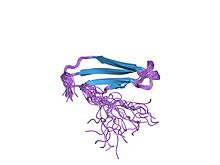WRKY protein domain
| WRKY | |||||||||
|---|---|---|---|---|---|---|---|---|---|
 solution structure of the c-terminal wrky domain of atwrky4 | |||||||||
| Identifiers | |||||||||
| Symbol | WRKY | ||||||||
| Pfam | PF03106 | ||||||||
| Pfam clan | CL0274 | ||||||||
| InterPro | IPR003657 | ||||||||
| |||||||||
The WRKY domain is found in the
Structure
WRKY transcription factors contain either one or two WRKY protein domains. The WRKY protein domain is 60 to 70 amino acids long type of DNA binding domain. The domain is characterized by a highly conserved core WRKYGQK motif and a zinc finger region. The cysteine and histidine zinc finger domain occurs as a CX4-5CX22-23HXH or CX7CX23HXC type, where X can be any amino acid.[3] The zinc finger binds a Zn+2 ion, which is required for protein function.[4] While the WRKYGQK is highly conserved in most WRKY domains, variation in the core sequence has been documented.[2][5] A frequently occurring variant of the core sequence is WRKYGKK, which is present in most plant species.[2][3][5][6][7]
The structure of the WRKY protein domain was first determined in 2005 using
WRKY-DNA Interaction
The WRKY domain forms a unique wedge-shaped structure that enters perpendicularly in the major groove of the DNA strand.[9] WRKY protein domains interact with the (T/A)TGAC(T/A) cis-element, also called the W-box.[1][10][11] Recent evidence suggests that the GAC core of the W-box is the primary target of the WRKY domain and flanking sequences help dictate DNA interaction with very specific WRKY proteins.[12] The RKYGQK residues of the core motif and additional arginine and lysine residues of the WRKY domain are responsible for interaction with the phosphate backbone of seven consecutive DNA base pairs, including the GAC core.[9][12] Changing the tryptophan, tyrosine, or either lysine of the WRKYGQK motif to alanine completely abolishes DNA-binding,[8][13] indicating these amino acids are essential for recognizing the W-box element. While not essential, altering the WRKYGQK motif arginine, glycine or glutamine to alanine reduces DNA-binding to the W-box.[8][13] Overall, these complex WRKY protein domain-DNA interactions results in gene activation necessary for numerous aspects of plant development and defense.
External links
- WRKY family at PlantTFDB: Plant Transcription Factor Database
- WRKY Transcription Factor Family at The Arabidopsis Information Resource
- The Rushton Lab
- The Somssich Lab
- The Shen Lab
- Somssich’s list of WRKY-related publications
- Eulgem Lab
